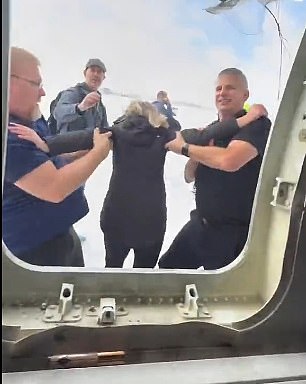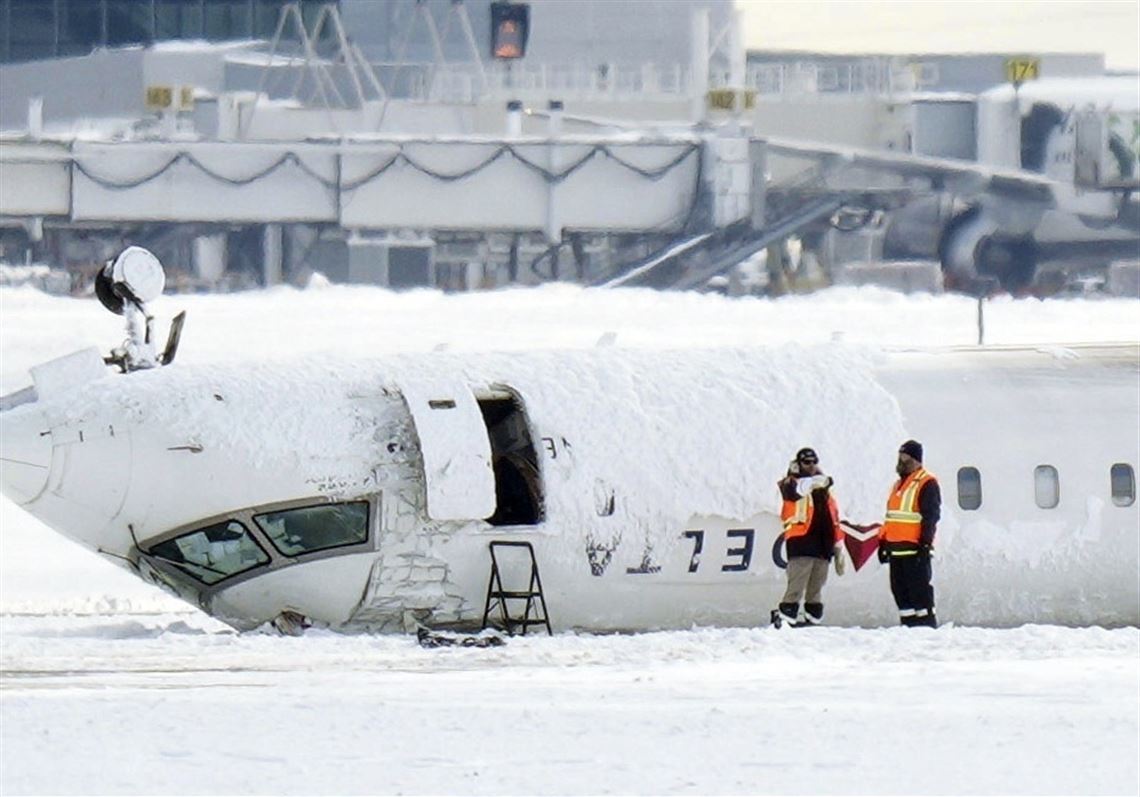On a fateful afternoon at Toronto Pearson International Airport, an Endeavor Airlines flight carrying 80 people met a disastrous fate, leaving at least 18 individuals injured, including a child. The crash of Endeavor Flight 4819 on the icy runway at approximately 2:15 PM local time led to a terrifying scene of panic, survival, and resilience. Among the passengers was Pete Koukov, who managed to capture the shocking aftermath from inside the overturned Delta jet.
The Crash and Immediate Aftermath
Endeavor Flight 4819 had taken off from Minneapolis just before noon, with a seemingly routine journey ahead. However, as it approached Toronto, treacherous weather conditions made landing hazardous. Strong winds and an icy runway contributed to the crash, resulting in the Bombardier CR900 aircraft flipping onto its back upon impact. The force of the landing was so severe that one of the aircraft’s wings snapped off, sending shockwaves through the cabin.
Inside the aircraft, chaos erupted as passengers, suspended upside down in their seats, scrambled to unbuckle their seatbelts and find a way to safety. The cabin had transformed into a scene of destruction, with overhead compartments flung open, luggage scattered across the ceiling, and seats eerily hanging from above. The sheer violence of the impact had turned the plane into a disorienting trap for those inside.

Survivor Footage Captures the Horror
Among the survivors was Pete Koukov, who managed to document the intense moments following the crash. His footage, which he later shared on Instagram, offered a firsthand look into the terrifying ordeal. In the video, petrified passengers are seen crawling toward an emergency exit as a flight attendant attempts to maintain order.
“Come on. Don’t take no video. Put that phone away,” a cabin crew member can be heard instructing passengers, prioritizing safety over documentation. However, Koukov’s footage continued, revealing the upside-down wreckage of the plane. A woman can be seen struggling to climb over the doorframe, aided by three men who grabbed her arms to help her safely exit. The urgency in their movements underscored the life-threatening nature of the situation.
Koukov was next to make his escape, capturing his own terrifying descent from the aircraft onto the snow-covered ground. The overturned plane loomed behind him as fire engines arrived at the scene, spraying water onto the wreckage. In the background, more passengers could be seen scrambling away from the aircraft, some running in sheer panic.

Shock and Gratitude Amidst the Chaos
As Koukov stood in the snow, still recording, the gravity of the moment sank in. His voice, filled with shock and disbelief, repeatedly uttered, “Holy f**k. Oh my f**ing God. Yo, I was just on this f**ing plane.” The realization that he had survived such a catastrophic event was overwhelming.
Later, reflecting on the incident, Koukov described the surreal experience of being trapped upside down. “We hit the ground, and we were sideways, and then we were upside down, hanging like bats,” he recounted. The process of unstrapping himself, navigating through the wreckage, and reaching the emergency exit felt like an eternity, though in reality, mere minutes had passed.
Despite the trauma, there was also an immense sense of gratitude. “Just feeling lucky and happy I got to give the person I didn’t know sitting next to me a big hug, that we were OK, and see my friends who are here to pick me up from the airport and give them a big hug,” Koukov shared. His words echoed the collective relief of all survivors who had walked away from the wreckage alive.

Challenges in the Evacuation Process
While Koukov was able to exit the plane with relative ease, not all passengers were as fortunate. Some individuals, either injured or in a state of shock, required assistance from fellow passengers and emergency responders. The scene inside the aircraft was chaotic, with some passengers disoriented and others struggling to move due to injuries. Flight attendants and crew members played a crucial role in guiding the evacuation, ensuring that everyone made it out as safely and swiftly as possible.
Outside the aircraft, first responders worked rapidly to assess the injured and transport them to medical facilities. Eighteen individuals sustained injuries, though none were reported to be life-threatening. Emergency personnel set up triage areas to provide immediate medical attention while others worked to secure the crash site.
Investigating the Cause of the Crash
As news of the crash spread, Canadian aviation authorities swiftly launched an investigation into the incident. The Transportation Safety Board of Canada, along with support from U.S. aviation experts, began analyzing flight data, weather conditions, and potential mechanical failures that may have contributed to the crash.
Preliminary reports suggest that the Bombardier CR900 approached the runway at a higher-than-recommended speed amidst strong winds and icy conditions. These factors may have played a role in the aircraft’s inability to land safely, ultimately leading to the catastrophic flip upon impact. However, authorities have urged patience as they work to piece together the full sequence of events.
In the meantime, two runways at Toronto Pearson International Airport were temporarily sealed off to facilitate the investigation and cleanup operations. The airline, Endeavor Air, a regional subsidiary of Delta Airlines, pledged full cooperation with investigators and extended support to passengers affected by the crash.
The Emotional Toll on Survivors
Beyond the physical injuries sustained, the psychological impact of the crash on survivors cannot be understated. Many passengers experienced immense fear and trauma, with some struggling to come to terms with the near-death experience. Experts emphasize the importance of mental health support in the aftermath of such incidents, as survivors may suffer from anxiety, post-traumatic stress disorder (PTSD), and recurring nightmares.
For Koukov and others, the crash served as a stark reminder of life’s fragility. His Instagram caption, “Being alive feels pretty cool today,” resonated with many, encapsulating the mix of gratitude and shock that comes with surviving a plane crash.
Aviation Safety and Lessons Learned
While commercial aviation remains one of the safest modes of transport, incidents like this highlight the importance of rigorous safety protocols and continued advancements in aviation technology. Pilots undergo extensive training to handle emergency situations, and aircraft are designed to withstand a range of adverse conditions. However, unpredictable weather and unforeseen circumstances can still pose significant risks.
In the wake of this crash, aviation experts will likely analyze the incident to determine potential improvements in aircraft design, landing procedures, and airport safety measures. The lessons learned from this event could contribute to future advancements in aviation safety, ensuring that similar incidents are prevented.
Conclusion
The crash of Endeavor Flight 4819 at Toronto Pearson International Airport was a terrifying ordeal for those on board. From the moment of impact to the frantic escape from the upside-down aircraft, survivors endured a harrowing experience that will stay with them forever. Through the chaos and fear, the resilience of passengers and crew members shone through, demonstrating the human instinct to survive and help others in times of crisis.
As investigations continue, authorities aim to uncover the exact cause of the crash and implement measures to enhance aviation safety. For those who lived through the incident, the experience serves as a poignant reminder of the unpredictability of life and the importance of cherishing every moment. In the words of one survivor, “Being alive feels pretty cool today.”

